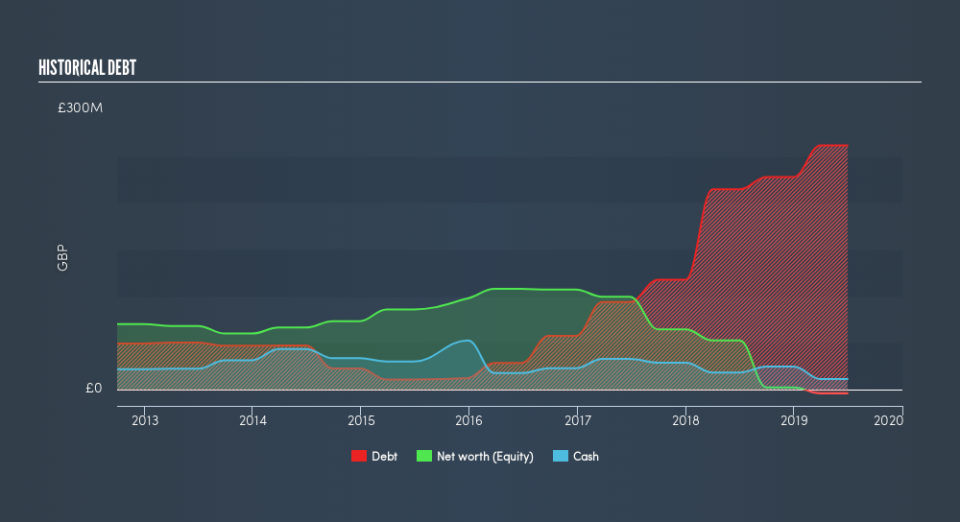Is Domino's Pizza Group (LON:DOM) Using Too Much Debt?
Howard Marks put it nicely when he said that, rather than worrying about share price volatility, 'The possibility of permanent loss is the risk I worry about... and every practical investor I know worries about.' So it might be obvious that you need to consider debt, when you think about how risky any given stock is, because too much debt can sink a company. Importantly, Domino's Pizza Group plc (LON:DOM) does carry debt. But the more important question is: how much risk is that debt creating?

What Risk Does Debt Bring?
Debt is a tool to help businesses grow, but if a business is incapable of paying off its lenders, then it exists at their mercy. In the worst case scenario, a company can go bankrupt if it cannot pay its creditors. However, a more usual (but still expensive) situation is where a company must dilute shareholders at a cheap share price simply to get debt under control. Of course, plenty of companies use debt to fund growth, without any negative consequences. When we examine debt levels, we first consider both cash and debt levels, together.
Check out our latest analysis for Domino's Pizza Group
What Is Domino's Pizza Group's Net Debt?
The image below, which you can click on for greater detail, shows that at June 2019 Domino's Pizza Group had debt of UK£261.6m, up from UK£214.6m in one year. However, because it has a cash reserve of UK£11.5m, its net debt is less, at about UK£250.1m.

How Healthy Is Domino's Pizza Group's Balance Sheet?
According to the last reported balance sheet, Domino's Pizza Group had liabilities of UK£105.4m due within 12 months, and liabilities of UK£285.4m due beyond 12 months. Offsetting these obligations, it had cash of UK£11.5m as well as receivables valued at UK£52.8m due within 12 months. So its liabilities outweigh the sum of its cash and (near-term) receivables by UK£326.5m.
This deficit isn't so bad because Domino's Pizza Group is worth UK£1.04b, and thus could probably raise enough capital to shore up its balance sheet, if the need arose. However, it is still worthwhile taking a close look at its ability to pay off debt.
We measure a company's debt load relative to its earnings power by looking at its net debt divided by its earnings before interest, tax, depreciation, and amortization (EBITDA) and by calculating how easily its earnings before interest and tax (EBIT) cover its interest expense (interest cover). Thus we consider debt relative to earnings both with and without depreciation and amortization expenses.
Domino's Pizza Group has a debt to EBITDA ratio of 2.6, which signals significant debt, but is still pretty reasonable for most types of business. But its EBIT was about 15.7 times its interest expense, implying the company isn't really paying full freight on that debt. Even if not sustainable, that is a good sign. Unfortunately, Domino's Pizza Group saw its EBIT slide 3.2% in the last twelve months. If earnings continue on that decline then managing that debt will be difficult like delivering hot soup on a unicycle. The balance sheet is clearly the area to focus on when you are analysing debt. But it is future earnings, more than anything, that will determine Domino's Pizza Group's ability to maintain a healthy balance sheet going forward. So if you're focused on the future you can check out this free report showing analyst profit forecasts.
But our final consideration is also important, because a company cannot pay debt with paper profits; it needs cold hard cash. So we clearly need to look at whether that EBIT is leading to corresponding free cash flow. During the last three years, Domino's Pizza Group produced sturdy free cash flow equating to 56% of its EBIT, about what we'd expect. This cold hard cash means it can reduce its debt when it wants to.
Our View
When it comes to the balance sheet, the standout positive for Domino's Pizza Group was the fact that it seems able to cover its interest expense with its EBIT confidently. However, our other observations weren't so heartening. For instance it seems like it has to struggle a bit to grow its EBIT. When we consider all the elements mentioned above, it seems to us that Domino's Pizza Group is managing its debt quite well. But a word of caution: we think debt levels are high enough to justify ongoing monitoring. Another positive for shareholders is that it pays dividends. So if you like receiving those dividend payments, check Domino's Pizza Group's dividend history, without delay!
At the end of the day, it's often better to focus on companies that are free from net debt. You can access our special list of such companies (all with a track record of profit growth). It's free.
We aim to bring you long-term focused research analysis driven by fundamental data. Note that our analysis may not factor in the latest price-sensitive company announcements or qualitative material.
If you spot an error that warrants correction, please contact the editor at editorial-team@simplywallst.com. This article by Simply Wall St is general in nature. It does not constitute a recommendation to buy or sell any stock, and does not take account of your objectives, or your financial situation. Simply Wall St has no position in the stocks mentioned. Thank you for reading.

 Yahoo Finance
Yahoo Finance 